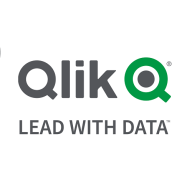

Qlik Sense and Splunk Cloud Platform compete in the data analytics and business intelligence category. Qlik Sense seems to have an advantage in user-friendliness and rapid application development, while Splunk Cloud Platform stands out with its enterprise security features and integration capabilities.
Features: Qlik Sense provides advanced data profiling, data preparation tools, and a robust associative engine supporting complex analysis. Its rapid application development and self-service tools are user-friendly. Splunk Cloud Platform excels in log aggregation, monitoring, and reporting. Its enterprise security features and integration abilities are crucial strengths.
Room for Improvement: Qlik Sense users seek better data integration, predictive analytics, and improved customization options. Set analysis usability poses challenges for non-technical users. Splunk Cloud Platform requires enhanced integrations, more user-friendly setup processes, and clearer pricing model understanding. Performance improvements and better support are also desired.
Ease of Deployment and Customer Service: Qlik Sense is flexible across on-premises and private cloud environments, ensuring adaptability. Its vibrant community offers support, though technical support response can be slow. Splunk Cloud Platform, primarily cloud-based, allows quick setup in public and hybrid clouds. Its customer service is positively rated although support can be occasionally sluggish.
Pricing and ROI: Qlik Sense is considered cost-effective for large enterprises, offering a licensing model that supports growth. It delivers ROI through quick decision-making and data analysis efficiency. Splunk Cloud Platform, despite its comprehensive features, is viewed as expensive for smaller organizations, with costs linked to data volumes. However, users often find the benefits justify the investment.
In my organization, we moved from OBI to Qlik Sense due to limitations with OBI, resulting in very high ROI.
While tech support is comprehensive, the stability of Qlik Sense means I generally do not need it.
In Turkey, the consultant firms are very professional, and they support you.
I think they lack in the support system.
Premium support is costly and may not always provide a satisfactory experience.
It performs well in terms of performance and load compared to others.
I believe it is easily scalable.
The stability is very good.
Providing an API feature to access data from the dashboard or QEDs could be beneficial.
Power BI has better visualizations and interactions with updates in 2023 that provide ease of use.
Maybe more AI or real-time analytics could be incorporated.
Splunk Cloud Platform needs improvement in its security offerings, specifically in cybersecurity.
Compared to Power BI, it is definitely costly.
Core-based licensing operates on a subscription mode, allowing unlimited users.
Among the BI tools and data analytics tools, Qlik is the most expensive.
Splunk Cloud is considered too expensive, with its two product offerings both being costly.
From an end-user perspective, it's convenient and performance-oriented, providing something meaningful from all the organization's data.
It is a single product that I can use as an ETL database, BI, and more.
It has an interactive interface with Qlik graphs, pivot, and interactivity, which makes it easier to use than other tools.
The most valuable feature of Splunk Cloud Platform is its robustness and ability to ingest logs.


Qlik Sense is a visual analytics and business intelligence (BI) platform that gives users full control over their system’s data. From this platform they can control every aspect of their system data. It maximizes an organization’s ability to make decisions driven by their data.
Benefits of Qlik Sense
Some of the benefits of using Qlik Sense include:
Reviews from Real Users
Qlik Sense stands out among its competitors for a number of reasons. Two major ones are its associative analytics technology and its remote access capability. Qlik Sense employs an associative analytics engine that gives users the ability to take their data analytics to the next level. Users can create visual connections between different datasets spread across their network, creating deep insights that enable users to gain a full understanding of their data. This engine is easily scaled up to allow a large number of users to benefit from the deep insights that it provides. Users can access Qlik Sense from anywhere in the world. Qlik Sense has an online portal that can be used consistently from anywhere at all. Having the ability to remotely analyze data gives users flexibility when it comes to choosing how to deploy their manpower.
Jarno L., the managing director of B2IT, writes, “The associative technology features are the solution's most valuable aspects. Qlik was the first company to implement an in-memory associative analytics engine. This basically means that all data is loaded into memory, but it also means that instead of joining data together, the data is associated together. From the front end, from the user interface point of view, data can be joined or included or excluded on the fly. It can be drilled down and drilled through and users can slice and dice it and that type of thing can be done from anywhere in the data to any other place in the data. It doesn't have to be predefined. It doesn't have to have hierarchies or anything like that.”
Tami S., the senior business intelligence analyst at the La Jolla Group, writes, “With the changing business landscape, it is nice to access Qlik Sense through an external website. As an organization when we use QlikView Desktop, we need to connect to our internal network. We can access QlikView through the QlikView access point but the website has a little different look and feel than the desktop application. We appreciate that Qlik Sense is browser-based and the user experience is the same whether at home, in the office or on a boat. As long as the user has internet access, performance is the same.”
Splunk Cloud Platform is widely used for log management, security monitoring, application performance monitoring, troubleshooting, data aggregation, and IT operations. It centralizes logs from numerous sources, enabling detailed analysis, incident detection, and effective dashboard creation.
Companies across various industries leverage Splunk Cloud Platform for cybersecurity, compliance, user activity monitoring, and alerts. It helps in managing cloud environments, optimizing data storage costs, and enhancing customer insights with effective data visualization. The platform's robust capabilities include customizable reporting, flexible log sending, powerful search features, and seamless integration with other systems. Users monitor multiple environments and platforms effortlessly with the cloud infrastructure maintained by Splunk. Despite its advantages, users find the pricing steep, support ineffective, and encounter performance issues with large data volumes. Integration challenges, limited training resources, and insufficient documentation also pose concerns.
What are the most important features of Splunk Cloud Platform?Splunk Cloud Platform is implemented across industries including finance, healthcare, retail, and technology. Organizations use it to enhance cybersecurity measures, meet compliance requirements, monitor user activities, and issue automated alerts. In finance, it assists in fraud detection and compliance. In healthcare, it ensures data security and regulatory adherence. Retailers use it for customer behavior analysis and performance monitoring, while technology companies benefit from its troubleshooting and log management capabilities. Despite its powerful features, companies face challenges with pricing, support, and integration that require consideration during implementation.
We monitor all Data Visualization reviews to prevent fraudulent reviews and keep review quality high. We do not post reviews by company employees or direct competitors. We validate each review for authenticity via cross-reference with LinkedIn, and personal follow-up with the reviewer when necessary.